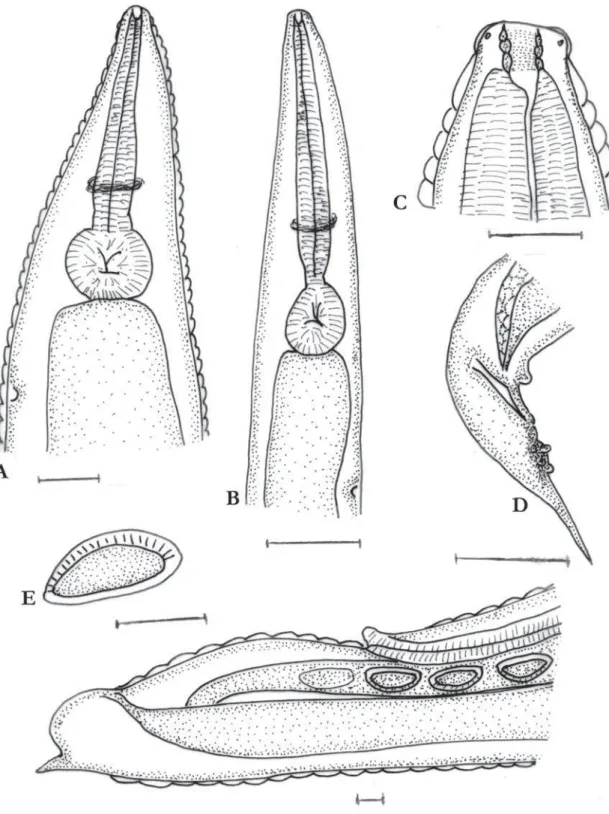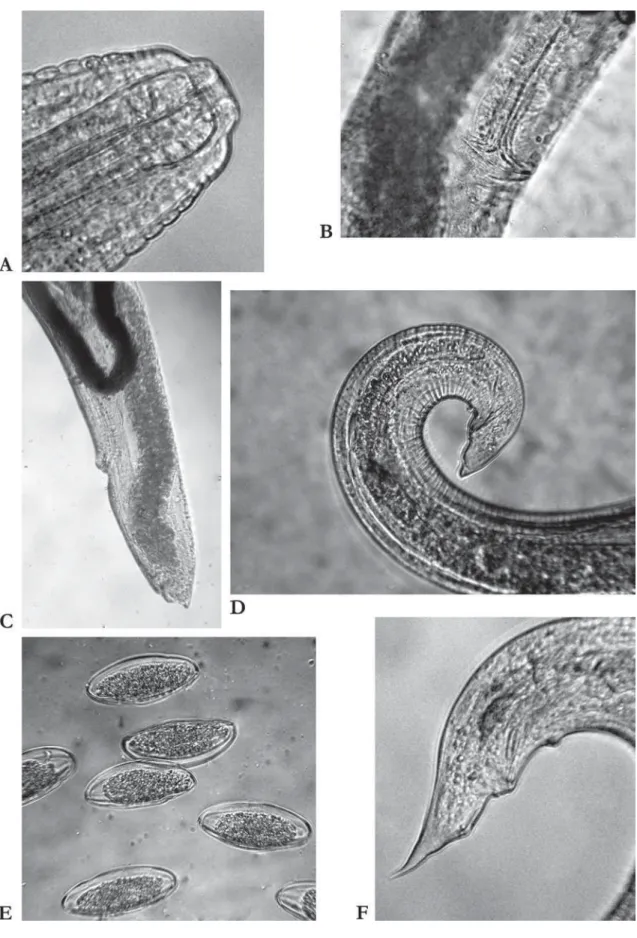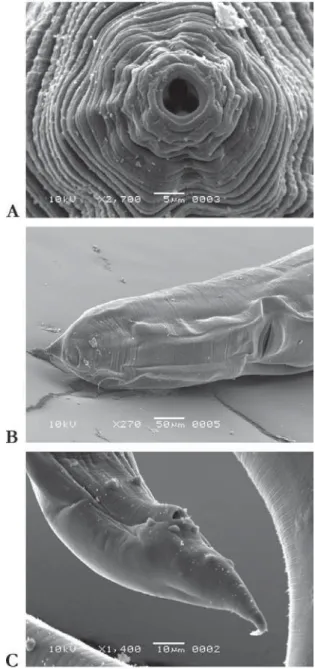Investigador CONICET, Centro de Estudios Parasitológicos y de Vectores, CEPAVE, Calle 2 Nº 584, La Plata, Argentina. Investigador CIC. CEPAVE. Fax: +54 221 4232327. E-mail: nemainst@cepave.edu.ar
1. 2.
A
NEW SPECIES OFB
LATTICOLAS
CHWENK, 1926 (O
XYURIDA,
T
HELASTOMATIDAE)
A PARASITE OFA
NUROGRYLLUS MUTICUS(D
EG
EER, 1773) (O
RTHOPTERA, G
RYLLIDAE)
FROMA
RGENTINAM
ARÍAF
ERNANDAA
CHINELLY1N
ORAB. C
AMINO2ABSTRACT
Blatticola cristovata n. sp. (Oxyurida, Thelastomatidae) a parasite of the cricket Anurogryllus
muticus (De Geer, 1773) (Orthoptera, Gryllidae) from Argentina, is described and illustrated. This
is the first species of the genus Blatticola found parasitizing cricket. This new species is characterized in females by having the cuticle annulated through the body length, the mouth opening is subtriangular and surrounded by eight cephalic papillae, the stoma is short with three pairs placed in two rows of cuticular sclerotised plates, amphids in small pore shaped, oesophagus is divided into three parts, anterior cylindrical corpus, isthmus distinct, and basal bulb valved, the nerve ring is situated around the middle of corpus, the intestine is wide broad anteriorly, oval eggs, smooth shell, with a straight side, and the other side with a band running longitudinally. Males with one pair of preanal, one pair of adanal and two pairs of postanal papillae, and the tail appendage short, conical and pointed.
KEYWORDS: Oxyurida, Thelastomatidae, Blatticola cristovata n. sp., Nematoda, taxonomy.
Blattellicola Basir (1940) and Blatellicoloides Farooqui
(1966) match Blatticola in all essential respects and
they are here considered synonyms of the latter. All species described until the present date are parasites of cockroaches from several regions of the world. While conducting field surveys on agricultural pests in the area of La Plata, province of Buenos Aires, Argentina, we found nymphs of crickets which were parasitized by a species of thelastomatid. In this
con-tribution we report a new species, Blatticola cristovata
n. sp., a parasite of the cricket Anurogryllus muticus (De
Geer, 1773) (Orthoptera, Gryllidae).
INTRODUCTION
The genus Blatticola was proposed by Swenk
(1926), who designated Blatticola blatticola (Galeb,
1877) as its type species. In 1932, Chitwood
con-sidered this species a synonym of Blatticola blattae
MATERIAL AND METHODS
Adults and nymphs of Anurogryllus muticus
(n=50) were found in a recreation park, located in Tolosa (34°55’S; 57°57’W), La Plata, Buenos Aires, Argentina. They were collected during 2005-2006, in plastic containers by hand and then placed in indi-vidual vials. The insects were kept at 5°C for 10 min, and then dissected in Petri dishes, filled with distilled water, under a stereoscope microscope. A transverse incision was made along the posterior end of the ab-domen and the digestive tract was removed to obtain the parasites. The nematodes were killed by placing them in distilled water at 60°C for 2 min. They were removed to a fixative, 50% TAF solution, water + tri-etanolamine formalin (1:1), for 48 h, and then placed into pure TAF (Poinar, 1975). The nematodes were transferred to glycerol for slow evaporation and to clear the parasites (Seinhorst, 1959). Fixed specimens were used for drawings and measurements using a lucida camera mounted on a Zeiss compound micro-scope. They were photographed by a Nikon digital camera. All measurements are in micrometers (µm), with ranges in parenthesis.
Micrographs were obtained with SEM and used to develop a description of the external ultrastructure of the nematodes cuticle. Males and females were fixed in 1.5% glutaraldehyde/1.5% formaldehyde buffered with 0.1M cacodylate buffer (pH 7.35) for 12 h at 8°C, post fixed with 1% osmium tetroxide solution for 12 h at 25°C. After post-fixation, nema-todes were rinsed three times in water (5 min. each), and dehydrated using a series of ethanol washes (30, 50, 70, 90, 100%), then critical point were dried with
liquid CO2, mounted on SEM stubs, and coated with
gold (Kaya & Stock, 1997). Observations of ultras-tructure were realized by SEM JEOL JSM-100.
RESULTS
Blatticola cristovata n. sp.*
(Figs. 1A-F, 2A-F, 3A-C)
Description: Small nematodes. Females have the cuticle annulated along the body. The second annule from anterior end is longer than the others (Fig. 2A). The first annule has small amphids, pore-shaped, small and circular amphidial apertures. Mouth hexagonal surrounded by eight papillae (Fig. 3A). The stoma is
* The species epithet is derived from the presence of longitudinal bands on the eggs.
longer than broad, without tooth, with thick sclero-tised walls forming three pairs of plates aligned in two rows (Figs. 1C, 2A). Oesophagus tripartite, in-distinctly sclerotised at anterior end, with a corpus subparallel-sided, expanded posteriorly, the isthmus is short, and basal bulb valved (Fig. 1A). The nerve ring is situated anterior to corpus and isthmus junc-tion. The excretory pore is posterior to the anterior end of the intestine. The intestine is broad, taper-ing posteriorly. Vulva located posteriorly, protrudtaper-ing, with one lip more developed, vagina long and narrow (Figs. 1F, 2B,C, 3B). Uterus single, directed forward from the vagina, and near the anterior end of the intestine, in a loop, then goes towards the posterior end of the intestine where it makes another loop, and ascends -until the level of the vulva. Ovary sin-gle directed anteriorly. eggs oval, smooth shell, with a straight side, and the other side with a band like a ridge, running longitudinally (Figs. 1E, 2E). Tail appendage short, conical and pointed (Figs. 1F, 2C, 3B).
Female (n = 38): Total length: 4,211 ± 95.7 µm (4,110-4,300); diameter of head at cephalic papil-lae level: 23.5 ± 2.42 µm (21.15-26); stoma length: 15.7 ± 3.8 µm (12.9-20); stoma width: 9.08 ± 2.6 µm (7.05-12); width of body at nerve ring level: 203.5 ± 4.13 µm (198.65-208); width of body at excre-tory pore level: 402.7 ± 33.5 µm (364-424); maximum body diameter: 453.3 ± 25.16 µm (420-480); width of body at posterior end level (anus): 114.3 ± 15.05 µm (100-130); width of body at vulva level: 270 ± 20 µm (250-290); distance from anterior end to nerve ring: 285.3 ± 47.6 µm (244-352); oesophagus length: 525.3 ± 24.4 µm (504-552); distance from anterior end to excretory pore: 875.3 ± 68.3 µm (816-950); vagina length: 320 ± 1.37 µm (240-350); vagina width: 46.6 ± 1.88 µm (43-48); V**: 83.08% ± 1.37 (81.5-84.02); eggs length and width: 84 ± 4 µm (80-88) x 34.6 ± 4 µm (32-36); tail appendage length: 25.3 ± 2.3 µm (22-25).
Males are smaller in size than females. Cuticle is slightly annulated along the body. Amphids are small and pore-shaped. Cephalic papillae are not visible at optical microscope. Stoma is longer than broad, with sclerotised walls and two rows with three pairs of plates, without tooth. The oesophagus and intestine are similar to female (Fig. 1B). nerve ring located an-terior to corpus and isthmus junction. Excretory pore is posterior to the anterior end of the intestine. Tes-tis single (monorchic), extended anteriorly, reflexed
posteriorly at midbody. Vas deferens evident. Spicule single, straight, forming an arrow, without sculpture, with pointed tip (Fig. 1D, 2D). Capitulum and guber-naculum absent. Genital papillae arranged
ventrola-terally in one pair of preanal, one pair of adanal and two pairs of postanal papillae (Fig. 1D, 2F, 3C). Tail appendage is short, conical and pointed (Fig. 1D, 2F, 3C).
FIGURE 1.Blatticola cristovata n. sp. A.female anterior end. B.male anterior end. C.female stoma. D.male posterior end, lateral view.
FIGURE 3.Blatticola cristovata n. sp. SEM photographs. A.Female stoma showing mouth opening. B.Vulva posterior lip (arrow).
C.Male posterior end, genital papillae (arrow).
Male (n = 30): Total length: 2,113 ± 221.8 µm
(1,930-2,360); diameter of head at cephalic pa-pillae level: 13.7 ± 0.68 µm (12.92-14.1); stoma length: 10.02 ± 2.35 µm (9.7-10.57); stoma width: 4.7 ± 0.15 µm (4.5-4.8); width of body at nerve ring level: 54.05 ± 2.35 µm (51.7-56.4); width of body at excretory pore level: 82.3 ± 6.23 µm (77.5-89.3); maximum body diameter: 103.4 ± 6.21 µm (98.7-110.45); width of body at anus level: 53.26 ± 9.78 µm (42.3-61.1); distance from anterior end to nerve ring:
117.5 ± 10.24 µm (112.8-129.25); oesophagus length: 235.78 ± 78.2 µm (223.25-244.4); distance from an-terior end to excretory pore: 465.3 µm (319.6-465.3); spicule length: 354.46 ± 1.35 µm (32.9-35.25); spic-ule width: 4.28 ± 0.72 µm (3.45-4.7); tail appendage length: 22.5 ± 3.58 µm (18.8-25.85).
Type host: nymphs of Anurogryllus muticus (De Geer) (Orthoptera, Gryllidae).
Type locality: Tolosa (34°55’S; 57°57’W), La Plata, Bue-nos Aires, Argentina.
Type material: Holotype, allotype and paratypes depos-ited in the Helminthological collection, Museo de La Plata, Nº 5485, paseo del Bosque s/n, 1900 La Plata, Argentina.
Site of infection: intestine, midgut.
Prevalence: 27%
Number of nematodes per larva: 3.93
DISCUSSION
Blatticola cristovata n. sp. is close to five species of
the genus: B. barryi Zervos, 1987; B. caucasica Skrjabin,
1923;B. monandros Zervos, 1983; B. supellaimae Rao &
Rao, 1965; B. tuapakae Dale, 1966. Females have the
intestine tapering posteriorly, and the nerve ring lo-cated around the corpus.
Blatticola barryi can be distinguished from B. cris-tovata by vulva position (17% of the body length), cu-ticle annulated only anteriorly, distinct rectal glands, eggs with operculum, male with three pairs of geni-tal papillae, and two shallow constrictions in the tail.
Blatticola caucasica is distinguished by having male with four pairs of genital papillae, from which two pairs are
preanal and two pairs are postanal. Blatticola monandros
can be characterized by the distance from vulva to anus being about 7-17% of body length, three pairs of tail genital papillae, cuticle annulated only anterior-ly, tail without sharply linear point, corpus not broad medially, flask shaped, egg with operculum, and
spi-cule short (less than 15 µm). Blatticola supellaimae is
separated by having the distance from vulva to anus about 5% of body length, four pairs of tail papillae, conical tail, sharply linear point, and nerve ring
locat-ed around half corpus. Blatticola tuapakae is different
papil-lae, cuticle annulated only anterior, convex and
co-noid tail, tending subulate near tip. Blatticola cristovata
n. sp. can be distinguished from the type species of
the genus, B. blattae. This one possesses the
diagnos-tic characterisdiagnos-tics of the genus, but differs from the new species by female posterior part of the intestine broader than medial intestine, outstretched testis in male and nerve ring situated around the isthmus, near base of the corpus.
Blatticola cristovata n. sp. is characterized by
i)female with annulated cuticle through the body,
ii)mouth opening subtriangular and surrounded by 8
cephalic papillae, iii)stoma short with three pairs of
cuticular sclerotised plates placed in two rows, iv)
am-phids aperture pore shaped, v)oesophagus divided
into three parts, anterior cylindrical corpus, isthmus
distinct, and basal bulb valved, vi)nerve ring located
around the middle of corpus, vii)intestine broad
an-teriorly, viii)oval eggs, smooth shell, with a straight
side, and the other side with a band running
longitu-dinally, ix)male with one pair of preanal, one pair of
adanal and two pairs of postanal papillae, and x)tail
appendage short, conical and pointed.
RESUMEN
Una nueva especie Blatticola cristovata n. sp. (Oxyurida, Thelastomatidae) parásita del grillo Anurogryllus muticus
(De Geer, 1773) (Orthoptera, Gryllidae) en Argentina, se describe e ilustra. Esta es la primera especie del género Blatticola
que se encontró parasitando a grillos. Esta nueva especie se caracteriza por tener las hembras la cutícula anillada a lo largo de todo el cuerpo, la abertura bucal triangular rodeada por ocho papilas cefálicas, el estoma corto con tres pares de placas esclerotizadas dispuestas en dos líneas, anfidios pequeños en forma de poro, esofago dividido en tres partes, una anterior con un corpus cilíndrico, un istmo distintivo, y un bulbo basal con valvas, el anillo nervioso situado rodeando el corpus, el intestino ensanchado anteriormente, huevos ovales, de cáscara lisa, con un lado recto y el otro con una cresta longitudinal. Macho con un par de papilas preanal, uno adanal y dos pares de papilas postanales, y apéndice caudal corto, cónico y punteagudo.
PALABRAS-CLAVE: Blatticola cristovata sp. n., Nematoda,
taxonomia.
REFERENCES
ADAMSON, M.L. & VAN WAEREBEKE, D. 1992. Revision of
the Thelastomatoidea, Oxyurida of invertebrate host. I. Thelastomatidae. Systematic parasitology, 21:21-63.
BASIR, M.A. 1940. Nematodes parasitic on Indian cockroaches.
Proceedings Indian Academy Sciences, 12:8-16.
CHITWOOD, B.G. 1932. A synopsis of the nematodes parasitic in
insects of the family Blattidae. Zeitschrift für Parasitenkunde,
5:14-50.
DALE, P.S. 1966.Blatticola tuapakae and Protellina gurri n. spp., nematode parasites of the black roach. New Zealand Journal of Sciences, 9:538-544.
DE GEER, C. 1773.Mémoires pour servir l’histoire des Insectes. Pierre Hesselberg, Stockholm, 696p.
FAROOQUI, M.N. 1966.Blatellicoloides blatti gen. et sp. nov. from
Blatella germanica. Indian Journal of Helminthology, 18:97-100. GALEB, O. 1877. Sur l’ anatomie et les migrations des Oxyurides,
parasites des insecte du genre Blatta. Comptes Rendus de l’ Academie des Sciences, Paris, 85:236-239.
GRAEFFE, E. 1860. Beobachtungen über Radiaten und Würmer in
Nizza.Denkschriften der Schweizerischen Naturforschende Gesellschaft,
17:59.
KAYA, H.K & STOCK, S.P. 1997. Techniques in insect nematology. In: Lacey, L.A (Ed.), Manual of techniques in insect pathology.
Academic Press, San Diego, p.281-324.
POINAR, G.O. JR. 1975.Entomogenous nematodes: A manual and host list of insect-nematode associations. E.J. Brill, Leiden, 317p. RAO, P.N. & RAO, V.J. 1965. A description of a new nematode of
the genus Blatticola (Schwenk, 1926). Annals and Magazine of Natural History, Serie 13, 8:273-275.
SCHWENK, J. 1926. Fauna parasitologica dos blattideos do Brasil.
Sciences Medica, Rio do Janeiro, 4:491-504.
SEINHORST, J.W. 1959. A rapid method for the transfer of nematodes from fixative to anhydrous glycerin. Nematologica, 10:87-94. SKRJABIN, K.I. 1923. Sur deux nouveaux nematodes parasites de
myriapodes. Annuaire du Musée Zoologique de l’Academie des Sciences de l’URSS, Leningrad, 27:304-309.
ZERVOS, S. 1983. Blatticola monandros n. sp. (Nematoda: Thelastomatidae) from the blattellid cockroach Parellipsidion pachycercum. New Zealand Journal of Sciences, 10:329-334. ZERVOS, S. 1987.Protellus dalei n. sp., Blatticola barryi n. sp., and
Suifunema mackenziei n. sp., thelastomatid nematodes from New Zealand cockroaches. New Zealand Journal of Sciences,
14:239-250.
Recebido em: 29.03.2007 Aceito em: 04.07.2007 Impresso em: 06.09.2007


